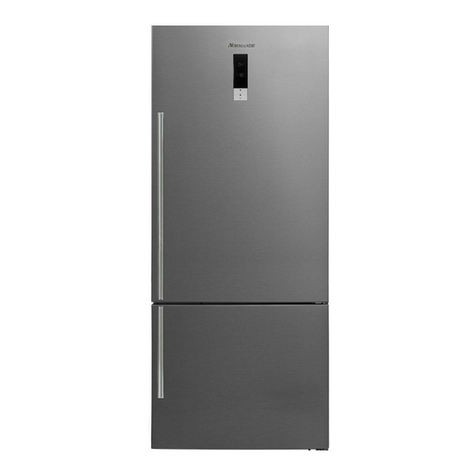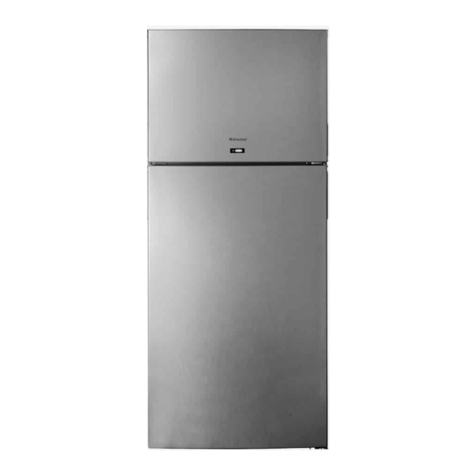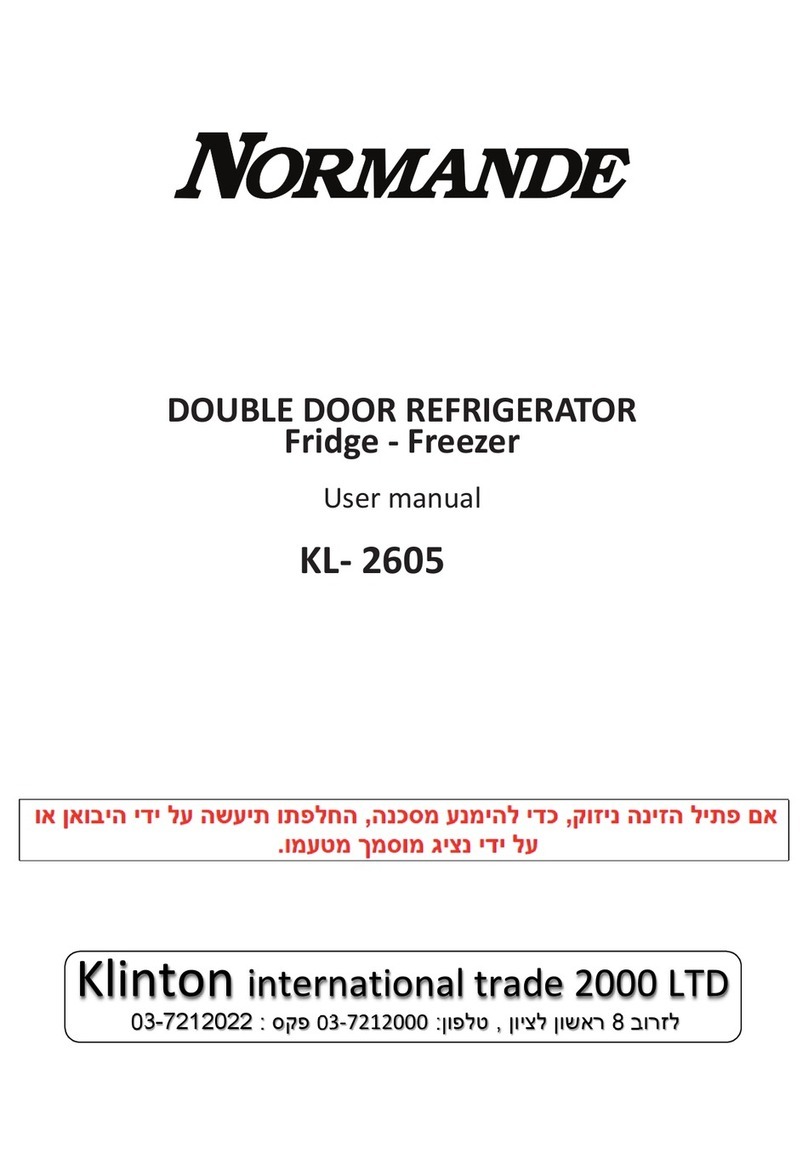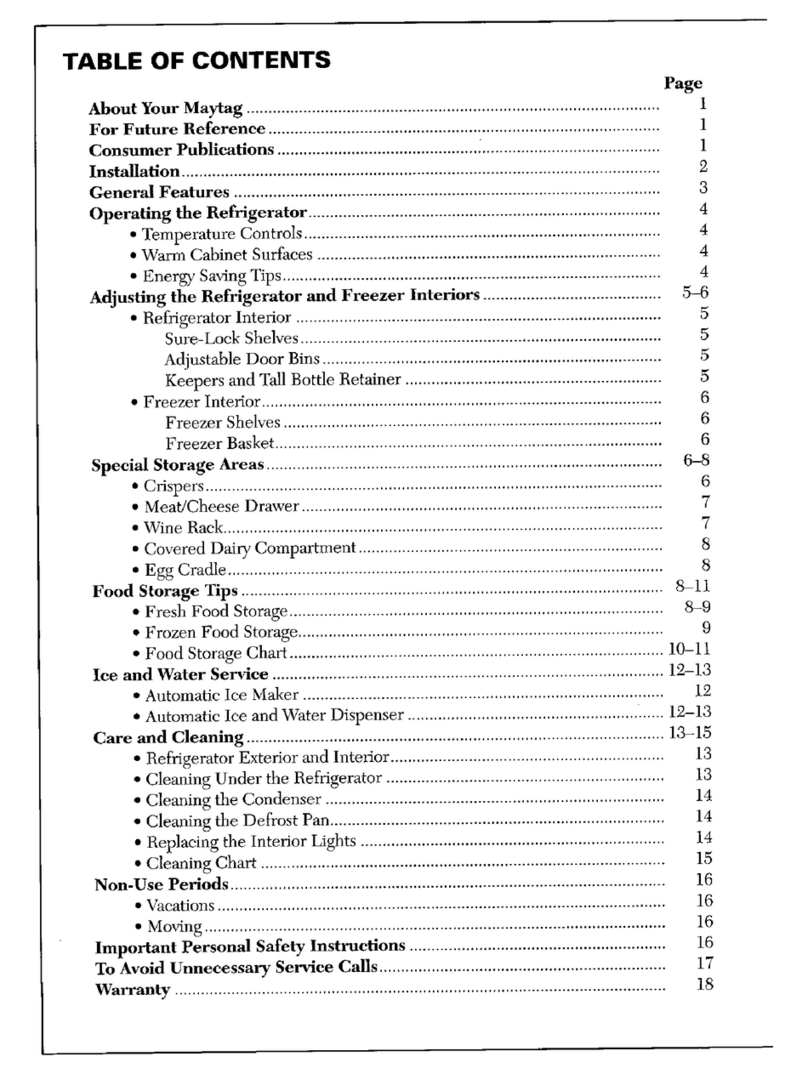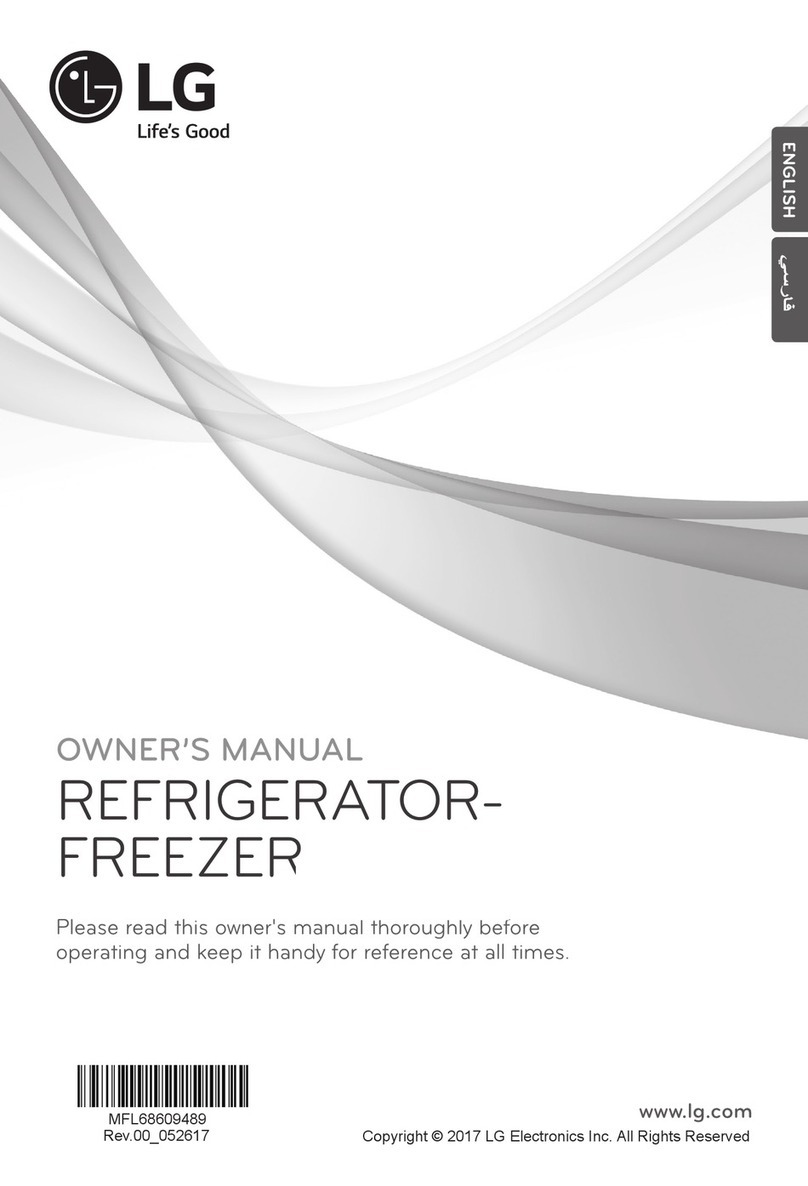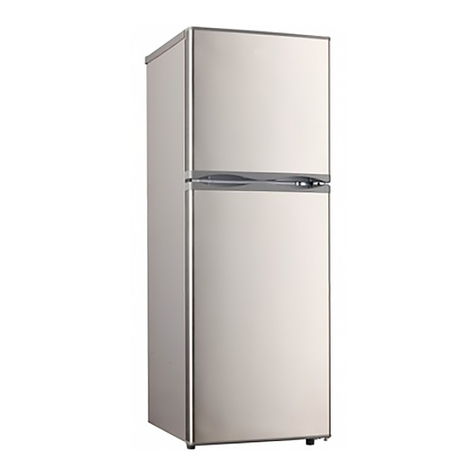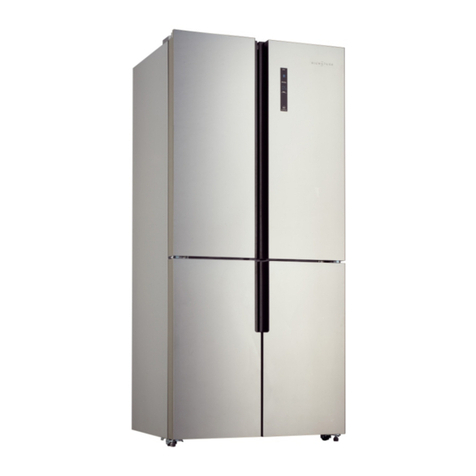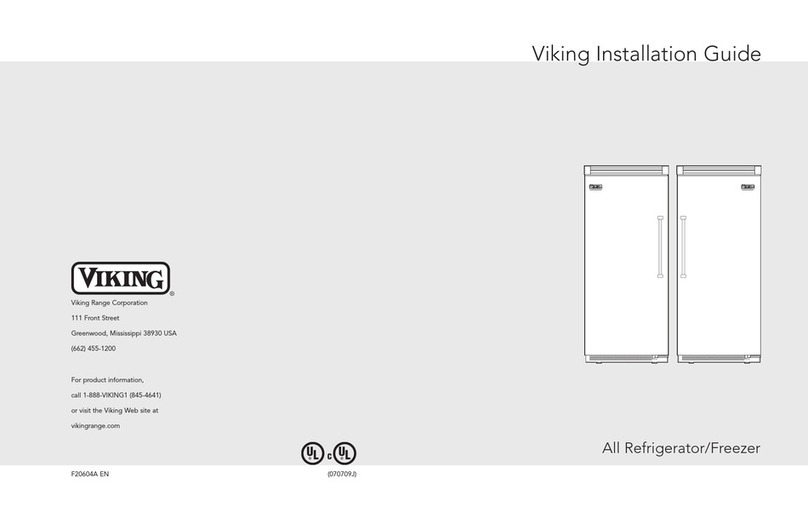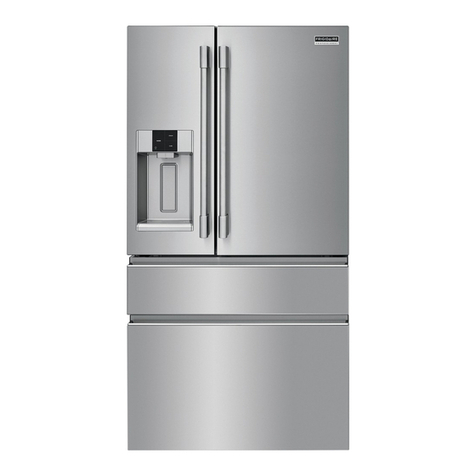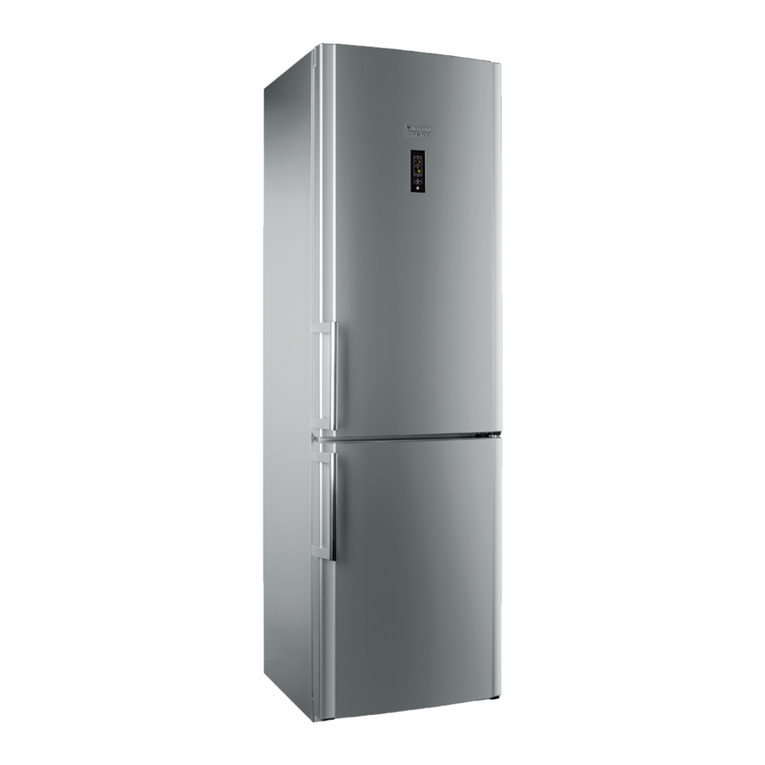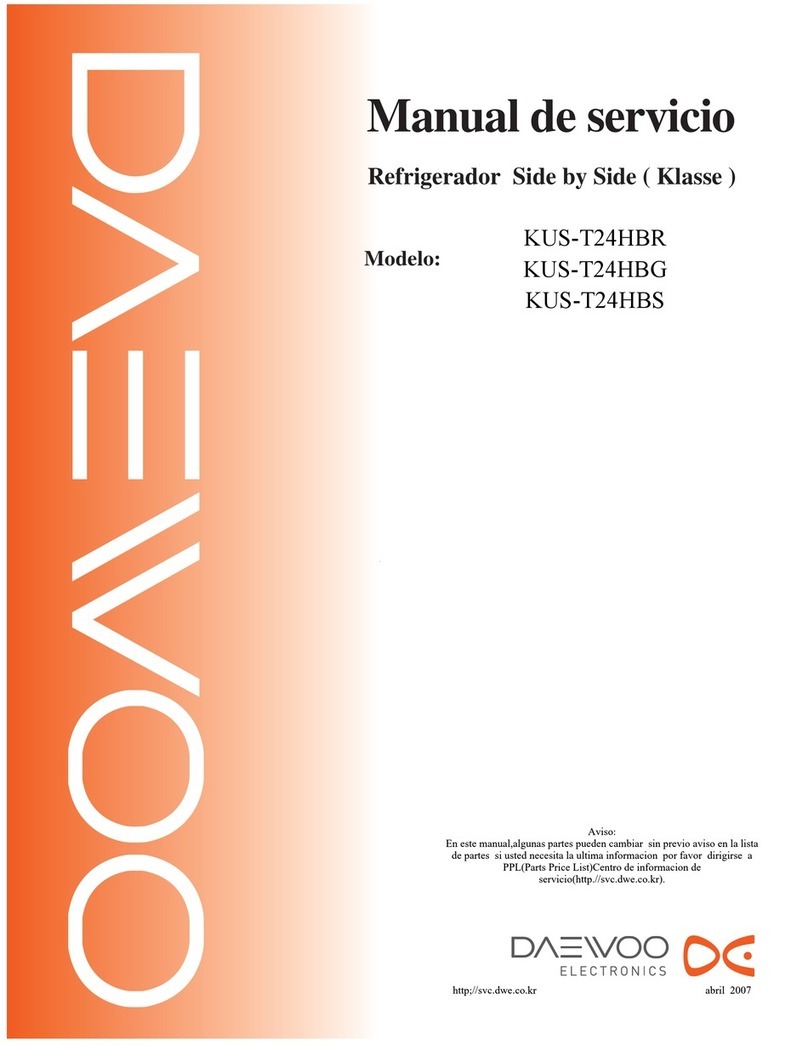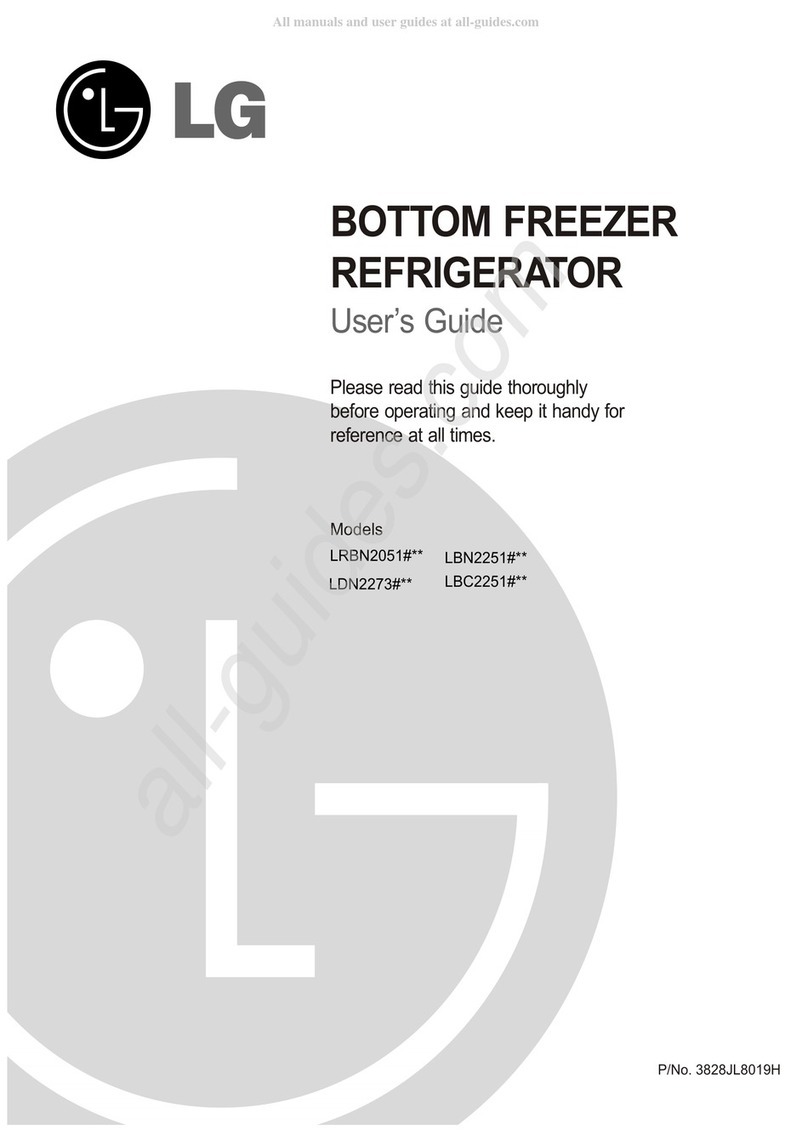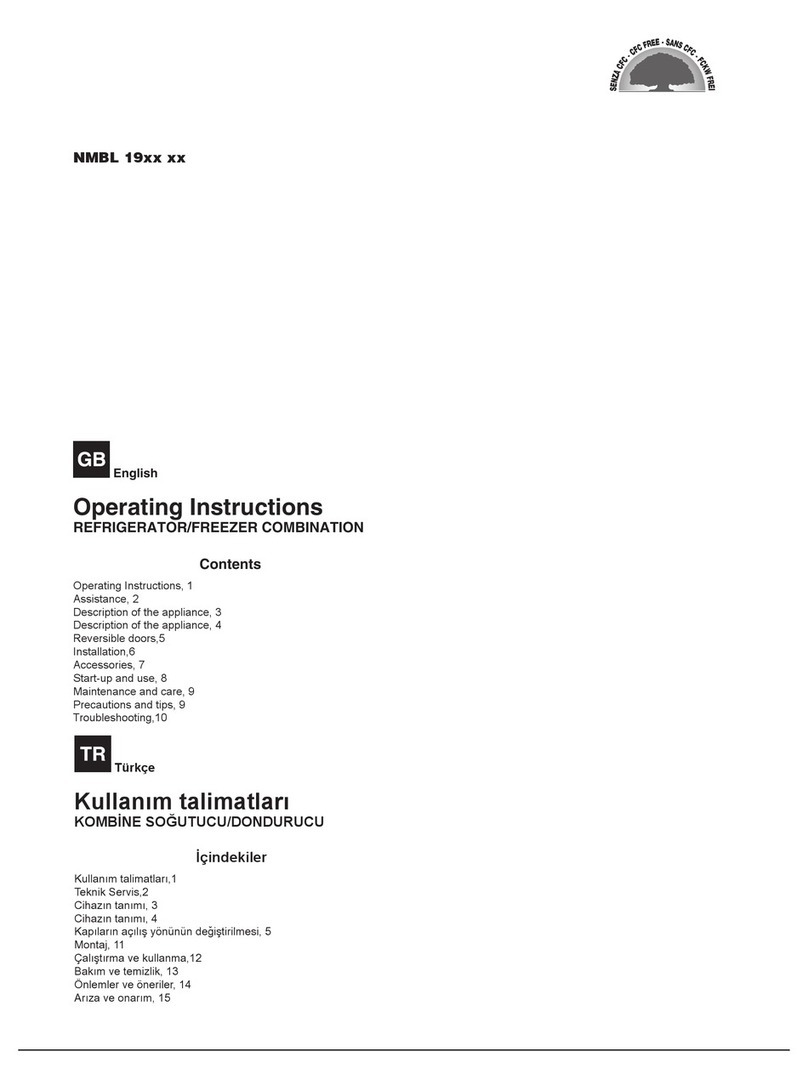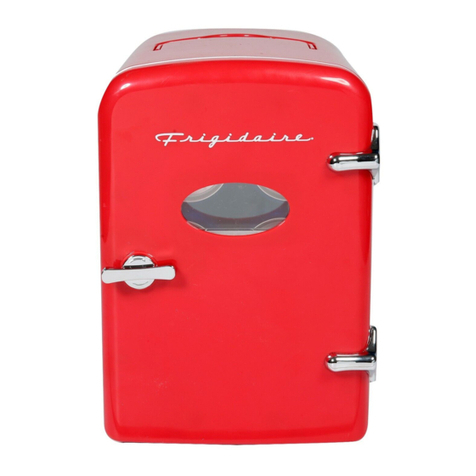Normande KL 473 S User manual

Freezer - Fridge / User ManualEN
KL 473 S
KL 473 W
R


EN -2-
INDEX
BEFORE USING THE APPLIANCE ......................................................... 3
General warnings ............................................................................................. 3
Old and out-of-order fridges or freezer............................................................. 6
Safety warnings................................................................................................ 6
Installing and operating your fridge freezer ...................................................... 7
Before Using your Fridge ................................................................................. 8
THE VARIOUS FUNCTION AND POSSIBILITIES ................................... 8
Information about New Generation Cooling Technology .................................. 8
Thermostat Setting ........................................................................................... 9
Temperature Adjustment Warnings .................................................................. 9
Accessories .................................................................................................... 10
The Icematic............................................................................................................10
The Chiller Shelf......................................................................................................10
The Fresh Dial.........................................................................................................11
ARRANGING FOOD IN THE APPLIANCE .............................................11
Refrigerator Compartment.............................................................................. 11
Freezer Compartment .................................................................................... 12
CLEANING AND MAINTENANCE ......................................................... 16
TRANSPORTATION AND CHANGING OF INSTALLATION POSITION17
Repositioning the Door................................................................................... 17
BEFORE CALLING YOUR AFTER SALES SERVICE........................... 18
Tips for saving energy .................................................................................... 19
THE PARTS OF THE APPLIANCE AND THE COMPARTMENTS ........ 20
The operating instructions apply to several models. Differences may therefore occur.
FIRE
Warning; Risk of re / ammable materials

EN -3-
BEFORE USING THE APPLIANCE
General warnings
WARNING: Keep ventilation openings, in the appliance
enclosure or in the built-in structure, clear of obstruction.
WARNING: Do not use mechanical devices or other means
to accelerate the defrosting process, other than those
recommended by the manufacturer.
WARNING: Do not use electrical appliances inside the food
storage compartments of the appliance, unless they are of the
type recommended by the manufacturer.
WARNING: Do not damage the refrigerant circuit.
WARNING: When positioning the appliance, ensure the
supply cord is not trapped or damaged.
WARNING: Do not locate multiple portable socket-outlets or
portable power supplies at the rear of the appliance.
WARNING: In order to avoid any hazards resulting from the
instability of the appliance, it must be xed in accordance with
the following instructions:
If your appliance uses R600a as a refrigerant (this information
will be provided on the label of the cooler) you should take care
during transportation and installation to prevent the cooler
elements from being damaged. R600a is an environmentally
friendly and natural gas, but it is explosive. In the event of a leak
due to damage of the cooler elements, move your fridge away
from open ames or heat sources and ventilate the room where
the appliance is located for a few minutes.
• While carrying and positioning the fridge, do not damage the
cooler gas circuit.
• Do not store explosive substances such as aerosol cans with
a ammable propellant in this appliance.
PART - 1.

EN -4-
• This appliance is intended to be used in household and
domestic applications such as:
- staff kitchen areas in shops, ofces and other working
environments.
- farm houses and by clients in hotels, motels and other
residential type environments.
- bed and breakfast type environments;
- catering and similar non-retail applications.
• If the socket does not match the refrigerator plug, it must be
replaced by the manufacturer, a service agent or similarly
qualied persons in order to avoid a hazard.
• A specially grounded plug has been connected to the power
cable of your refrigerator. This plug should be used with
a specially grounded socket of 16 amperes. If there is no
such socket in your house, please have one installed by an
authorised electrician.
• This appliance can be used by children aged from 8 years
and above and persons with reduced physical, sensory or
mental capabilities or lack of experience and knowledge if they
have been given supervision or instruction concerning use
of the appliance in a safe way and understand the hazards
involved. Children shall not play with the appliance. Cleaning
and user maintenance shall not be made by children without
supervision.
• Children aged from 3 to 8 years are allowed to load and
unload refrigerating appliances. Children are not expected
to perform cleaning or user maintenance of the appliance,
very young children (0-3 years old) are not expected to use
appliances, young children (3-8 years old) are not expected to
use appliances safely unless continuous supervision is given,
older children (8-14 years old) and vulnerable people can
use appliances safely after they have been given appropriate

EN -5-
supervision or instruction concerning use of the appliance.
Very vulnerable people are not expected to use appliances
safely unless continuous supervision is given.
• If the supply cord is damaged, it must be replaced by the
manufacturer, an authorised service agent or similar qualied
persons, in order to avoid a hazard.
• This appliance is not intended for use at altitudes exceeding
2000 m.
To avoid contamination of food, please respect the
following instructions:
• Opening the door for long periods can cause a signicant
increase of the temperature in the compartments of the
appliance.
• Clean regularly surfaces that can come in contact with food
and accessible drainage systems
• Store raw meat and sh in suitable containers in the
refrigerator, so that it is not in contact with or drip onto other
food.
• Two-star frozen-food compartments are suitable for storing
pre-frozen food, storing or making ice cream and making ice
cubes.
• One-, two- and three-star compartments are not suitable for
the freezing of fresh food.
• If the refrigerating appliance is left empty for long periods,
switch off, defrost, clean, dry, and leave the door open to
prevent mould developing within the appliance.

EN -6-
Old and out-of-order fridges or freezer
• If your old fridge or freezer has a lock, break or remove the lock before discarding it,
because children may get trapped inside it and may cause an accident.
• Old fridges and freezers contain isolation material and refrigerant with CFC. Therefore,
take care not to harm environment when you are discarding your old fridges.
Disposal of your old appliance
The symbol on the product or on its packaging indicates that this product may not
be treated as household waste. Instead it shall be handed over to the applicable
collection point for the recycling of electrical and electronic equipment. By ensuring
this product is disposed of correctly, you will help prevent potential negative
consequences for the environment and human health, which could otherwise
be caused by inappropriate waste handling of this product. For more detailed
information about recycling of this product, please contact your local city ofce, your household
waste disposal service or the shop where you purchased the product.
Notes:
• Please read the instruction manual carefully before installing and using your appliance.
We are not responsible for the damage occurred due to misuse.
• Follow all instructions on your appliance and instruction manual, and keep this manual
in a safe place to resolve the problems that may occur in the future.
• This appliance is produced to be used in homes and it can only be used in domestic
environments and for the specied purposes. It is not suitable for commercial or common
use. Such use will cause the guarantee of the appliance to be cancelled and our company
will not be responsible for the losses to be occurred.
• This appliance is produced to be used in houses and it is only suitable for cooling / storing
foods. It is not suitable for commercial or common use and/or for storing substances
except for food. Our company is not responsible for the losses to be occurred in the
contrary case.
Safety warnings
• Do not connect your fridge freezer to the mains electricity supply using
an extension lead.
• Do not use damaged, torn or old plugs.
• Do not pull, bend or damage the cord.
• Do not use plug adapter.
• This appliance is designed for use by adults. Do not allow children to
play with the appliance or hang off the door.
• Never touch the power cord/plug with wet hands. This may cause a short
circuit or electric shock.

EN -7-
• Do not place glass bottles or cans in the ice-making compartment as
they will burst when the contents freeze.
• Do not place explosive or ammable material in your fridge. Place drinks
with high alcohol content vertically in the fridge compartment and make
sure their tops are tightly closed.
• When removing ice from the ice-making compartment, do not touch it. Ice may
cause frost burns and/or cuts.
• Do not touch frozen goods with wet hands. Do not eat ice-cream or ice cubes
immediately after they are removed from the ice-making compartment.
• Do not re-freeze thawed frozen food. This may cause health issues such as food
poisoning.
Installing and operating your fridge freezer
Before using your fridge freezer for the rst time, please pay attention to the following points:
• The operating voltage for your fridge freezer is 220-240 V at 50Hz.
• The plug must be accessible after installation.
• Your fridge freezer may have an odour when it is operated for the rst time. This is normal
and the odour will fade when your fridge freezer starts to cool.
• Before connecting your fridge freezer, ensure that the information on the data plate
(voltage and connected load) matches that of the mains electricity supply. If in doubt,
consult a qualied electrician.
• Insert the plug into a socket with an efcient ground connection. If the socket has no
ground contact or the plug does not match, we recommend you consult a qualied
electrician for assistance.
• The appliance must be connected with a properly installed fused socket. The power
supply (AC) and voltage at the operating point must match with the details on the name
plate of the appliance (the name plate is located on the inside left of the appliance).
• We do not accept responsibility for any damages that occur due to ungrounded usage.
• Place your fridge freezer where it will not be exposed to direct sunlight.
• Your fridge freezer must never be used outdoors or exposed to rain.
• Your appliance must be at least 50 cm away from stoves, gas ovens and heater cores,
and at least 5 cm away from electrical ovens.
• If your fridge freezer is placed next to a deep freezer, there must be at least 2 cm between
them to prevent humidity forming on the outer surface.
• Do not cover the body or top of fridge freezer with lace. This will affect the performance
of your fridge freezer.
• Clearance of at least 150 mm is required at the top of your appliance. Do
not place anything on top of your appliance.
• Do not place heavy items on the appliance.
• Use the adjustable front legs to make sure your appliance is level and stable.
You can adjust the legs by turning them in either direction. This must be
done before placing food in the appliance.
• Clean the appliance thoroughly before use (see Cleaning and Maintenance).

EN -8-
• Before using your fridge freezer, wipe all parts with a solution of warm water and a
teaspoon of sodium bicarbonate. Then, rinse with clean water and dry. Return all parts
to the fridge freezer after cleaning.
THE VARIOUS FUNCTION AND POSSIBILITIES
Information about New Generation Cooling Technology
Fridges with new-generation cooling technology have a different
operating system to static fridges. Other (static) fridges may
experience a build up of ice in the freezer compartment due to
door openings and humidity in the food. In such fridges, regular
defrosting is required; the fridge must be switched off, the frozen
food moved to a suitable container and the ice which has formed
in the freezer compartment removed.
In fridges with new-generation cooling technology, a fan blows dry
cold air evenly throughout the fridge and freezer compartments. The
cold air cools your food evenly and uniformly, preventing humidity
and ice build-up.
In the refrigerator compartment, air blown by the fan, located at
the top of the refrigerator compartment, is cooled while passing
through the gap behind the air duct. At the same time, the air is
blown out through the holes in the air duct, evenly spreading cool
air throughout the refrigerator compartment.
There is no air passage between the freezer and refrigerator
compartments, therefore preventing the mixing of odours.
As a result, your fridge, with new-generation cooling technology,
provides you with ease of use as well as a huge volume and
aesthetic appearance.
PART - 2.
If your refrigerator includes a fan condenser
The condenser of your fridge is placed at the bottom
of cabinet. As a result of that, assemble the spacer
by xing it to holes on the cover bottom panel and
turn 90° that’s shown below gure for arranging the
distance between the refrigerator and the back wall at
where you place the fridge. You can move the fridge
towards the back wall until that point.
The distance between the appliance and back wall
must be a maximum of 75 mm.
Before Using your Fridge
• When using your fridge for the rst time, or after transportation, keep it
in an upright position for at least 3 hours before plugging into the mains.
This allows efcient operation and prevents damage to the compressor.
• Your fridge may have a smell when it is operated for the rst time. This is normal and
the smell will fade away when your fridge starts to cool.
Plastic for distance setting

EN -9-
Thermostat Setting
The freezer and refrigerator thermostats automatically
regulate the temperature inside the compartments.
Rotate the knob to a higher position, from 1 to 5, to
obtain colder temperatures. During cooler seasons,
set the thermostat to lower positions to reduce energy
consumption.
Thermostat knob
Temperature Adjustment Warnings
• It is not recommended that you operate your
fridge in environments colder than 10°C in terms
of its efciency.
• Temperature adjustments should be made
according to the frequency of door openings,
the quantity of food kept inside the fridge and
the ambient temperature in the location of your
fridge.
• In order to allow your fridge to reach the
operating temperature after being connected
to mains, do not open the doors frequently
or place large quantities of food in the fridge.
Please note that, depending on the ambient temperature, it may take 24 hours for your
fridge to reach the operating temperature.
• A 5 minute delay function is applied to prevent damage to the compressor of your fridge
when connecting or disconnecting to mains, or when an energy breakdown occurs. Your
fridge will begin to operate normally after 5 minutes.
• Your appliance is designed to operate in the
ambient temperature (T/SN = 10°C - 43°C) intervals
stated in the standards, according to the climate
class displayed on the information label. We do
not recommend operating your appliance out of
the stated temperature limits in terms of cooling
effectiveness.
Notes:
This fridge is designed to work in all ambient temperatures. In ambient temperatures
below -5 oC, do not place fresh food in the refrigerator compartment because the food
will have a temperature close to the ambient temperature and will freeze. Food can be stored
up to -5 oC in the refrigerator compartment. Food must be stored in the freezer compartment
when the ambient temperature is below -5 oC.
This appliance is designed to work at 43 oC ambient temperature with no problems.
Below -5 oC ambient temperature, do not use the refrigerator compartment as the foods
that you put into there will freeze. You can continue using the freezer compartment.
Door open alarm function
If cooler or freezer door is opened more than 2 minutes , appliance sounds ‘beep beep’.
Climate
Class Ambient Temperature oC
T Between 16 and 43 (°C)
ST Between 16 and 38 (°C)
N Between 16 and 32 (°C)
SN Between 10 and 32 (°C)

EN -10-
Accessories
The Icematic
• Pull the lever towards you and remove the
ice maker tray
• Fill with water to the marked level
• Hold the left end of the lever and set the
ice-tray on the icebox
• When ice cubes have formed, twist the lever
to drop the ice cubes into the icebox.
Note:
Do not ll the icebox with water in order to make ice. It can be broken.
The movement of the ice maker may be difcult while the refrigerator is running. In such
a case should be cleaned by removing the glass shelves.
Removing the icemaker
• Take out of the freezer glass shelves
• Remove the icemaker by dragging left or
right on the shelf.
You can remove the icemaker to use a larger
volume of the freezer compartment.
The Chiller Shelf
Keeping food in the Chiller compartment, instead
of the freezer or refrigerator compartments, allows
food to retain freshness and avour for longer, while
preserving its fresh appearance. When the Chiller
tray becomes dirty, remove it and wash with water.
(Water freezes at 0°C, but food containing salt or
sugar freezes at temperatures lower than this).
The Chiller compartment is usually used for storing
foods such as raw sh, lightly pickled food, rice, and
so on.
Do not put food you want to freeze or ice trays (to make ice) in the Chiller
compartment.
To remove the Chiller Shelf:
• Pull the chiller shelf towards you by sliding it
on the rails.
• Pull the chiller shelf up from the rail and remove
it from the fridge.
After the chiller shelf is removed, there will be
space for up to 20kg of food to be placed in the
fridge.
Chiller shelf

EN -11-
The Fresh Dial
If the crisper is full, the fresh dial located in front of the
crisper should be opened. This allows the air in the
crisper and the humidity rate to be controlled, to increase
the life of food within.
The dial, located behind the shelf, must be opened if any
condensation is seen on the glass shelf.
Fresh dial
(In some models)
Visual and text descriptions in the accessories section may vary according
to the model of your appliance.
Refrigerator Compartment
It is sufcient to set the fridge thermostat to position ‘2’ or ‘3’ for normal operatingconditions.
• To reduce humidity and avoid the consequent formation of frost, always store liquids in
sealed containers in the refrigerator. Frost tends to concentrate in the coldest parts of
the evaporating liquid and, in time, your appliance will require more frequent defrosting.
• Never place warm food in the refrigerator. Warm food should be allowed to cool at room
temperature and should be arranged to ensure adequate air circulation in the refrigerator
compartment.
• Make sure no items are in direct contact with the rear wall of the appliance as frost will
develop and packaging will stick to it. Do not open the refrigerator door frequently.
• We recommend that meat and clean sh are loosely wrapped and stored on the glass
shelf just above the vegetable bin where the air is cooler, as this provides the best
storage conditions.
• Store loose fruit and vegetable items in the crisper containers.
• Store loose fruit and vegetables in the crisper.
• Storing fruit and vegetables separately helps prevent ethylene-sensitive vegetables
(green leaves, broccoli, carrot, etc.) being affected by ethylene-releaser fruits (banana,
peach, apricot, g etc.).
• Do not put wet vegetables into the refrigerator.
• Storage time for all food products depends on the initial quality of the food and an
uninterrupted refrigeration cycle before refrigerator storage.
• To avoid cross-contamination do not store meat products with fruit and vegetables.
Water leaking from meat may contaminate other products in the refrigerator. You should
package meat products and clean any leakages on the shelves.
• Do not put food in front of the air ow passage.
ARRANGING FOOD IN THE APPLIANCEPART - 3.
To activate “sabbath” mode, insert the lever into
slot on top of the switch rmly as shown in the
picture. To deactivate “sabbath” mode, remove
the lever gently.
Sabbath mode

EN -12-
• Consume packaged foods before the recommended expiry date.
IMPORTANT NOTES:
Potatoes, onions and garlic should not be stored in the
refrigerator.
Cooked dishes must remain covered when they are
kept in the fridge. Place them in the fridge when they
are cool, otherwise the temperature/humidity inside the fridge
will increases, reducing the fridge’s efciency. Covering food
and drink also preserves their avour and aroma.
Do not allow food to come into contact with the
temperature sensor, which is located in the refrigerator
compartment, in order to keep the refrigerator compartment
at optimum temperature.
The table below is a quick guide to show you the most efcient way to store the major food
groups in your refrigerator compartment.
Food Maximum storage time How and where to store
Vegetables and fruits 1 week Vegetable bin
Meat and sh 2 - 3 Days Wrap in plastic foil, bags, or in a meat
container and store on the glass shelf
Fresh cheese 3 - 4 Days On the designated door shelf
Butter and margarine 1 week On the designated door shelf
Bottled products e.g.
milk and yoghurt
Until the expiry date
recommended by the
producer
On the designated door shelf
Eggs 1 month On the designated egg shelf
Cooked food All shelves
Freezer Compartment
• The freezer is used for storing frozen food, freezing fresh food, and making ice cubes.
• For freezing fresh food; wrap and seal fresh food properly, that is the packaging should
be air tight and shouldn’t leak. Special freezer bags, aluminum foil polythene bags and
plastic containers are ideal.
• Do not store fresh food next to frozen food as it can thaw the frozen food.
• Before freezing fresh food, divide it into portions that can be consumed in one sitting.
• Consume thawed frozen food within a short period of time after defrosting
• Never place warm food in the freezer compartment as it will thaw the frozen food.
• Always follow the manufacturer's instructions on food packaging when storing frozen
food. If no information is provided food, should not be stored for more than 3 months
from the date of purchase.
• When purchasing frozen food, make sure that it has been stored under appropriate
conditions and that the packaging is not damaged.
• Frozen food should be transported in appropriate containers and placed in the freezer
as soon as possible.
Temperature sensor area

EN -13-
• Do not purchase frozen food if the packaging shows signs of humidity and abnormal
swelling. It is probable that it has been stored at an unsuitable temperature and that
the contents have deteriorated.
• The storage life of frozen food depends on the room temperature, the thermostat setting,
how often the door is opened, the type of food, and the length of time required to transport
the product from the shop to your home. Always follow the instructions printed on the
packaging and never exceed the maximum storage life indicated.
• The maximum amount of fresh food (in kg) that can be frozen in 24 hours is indicated
on the appliance label.
• To freeze fresh food, ensure that as much of the surface of the food as possible is in
contact with the cooling surface.
• For optimum appliance performance to reach maximum freezing capacity, turn the
thermostat knob to the coldest setting 24 hours before placing fresh food in the freezer.
• It is generally sufcient to set the thermostat to the coldest setting for a further 24 hours
after placing the fresh food in the freezer. After this time, reduce the thermostat knob
setting if required.
• Attention. To save energy, if you are only freezing small amounts of food, do not set the
thermostat knob to the coldest setting.
In some models: While loading the freezer compartment, do not ll above
the guidelines otherwise the door will not close properly. If the freezer
compartment door does not close properly, excess ice will form in the freezer
compartment. To prevent the problem recurring, clear the ice and make
sure the door is fully closed.
Also, not closing the freezer and/or fridge compartment doors will increase
your energy consumption.
If the lower shelf of the freezer door is removed and
food obstructs the air suction hole, the efciency of
your fridge will reduce.
Therefore, take care while loading the freezer
compartment and make sure not to cover the air
suction hole.
Important note:
• Never refreeze thawed frozen food.
• The taste of some spices found in cooked dishes (anise, basilica, watercress, vinegar,
assorted spices, ginger, garlic, onion, mustard, thyme, marjoram, black pepper, etc.)
changes and they assume a strong taste when they are stored for a long period of time.
Therefore, add small amounts of spices to food to be frozen, or the desired spice should
be added after the food has thawed.
Air suction hole

EN -14-
• The storage time of food is dependent on the type of oil used. Suitable oils are margarine,
calf fat, olive oil and butter. Unsuitable oils are peanut oil and pig fat.
• Food in liquid form should be frozen in plastic cups and other food should be frozen in
plastic folios or bags.
The table below is a quick guide to show you the most efcient way to store the major
food groups in your freezer compartment.
Meat and sh Preparation Maximum storage time
(months)
Steak Wrap in foil 6 - 8
Lamb meat Wrap in foil 6 - 8
Veal roast Wrap in foil 6 - 8
Veal cubes In small pieces 6 - 8
Lamb cubes In pieces 4 - 8
Minced meat In packaging without using spices 1 - 3
Giblets (pieces) In pieces 1 - 3
Bologna sausage/
salami
Should be kept packaged even if it has a
membrane
Chicken and turkey Wrap in foil 4 - 6
Goose and duck Wrap in foil 4 - 6
Deer, rabbit, wild
boar In 2.5 kg portions or as llets 6 - 8
Freshwater sh
(Salmon, Carp,
Crane, Catsh)
After cleaning the bowels and scales of the
sh, wash and dry it. If necessary, remove the
tail and head.
2
Lean sh (Bass,
Turbot, Flounder) 4
Fatty shes (Tuna,
Mackerel, Bluesh,
Anchovy)
2 - 4
Shellsh Clean and in a bag 4 - 6
Caviar In its packaging, or in an aluminium or plastic
container 2 - 3
Snails In salty water, or in an aluminium or plastic
container 3
NOTE: Thawed frozen meat should be cooked as fresh meat. If the meat is not cooked after
defrosting, it must not be re-frozen.
Vegetables and Fruits Preparation Maximum storage time
(months)
String beans and
beans Wash, cut into small pieces and boil in water 10 - 13
Beans Hull, wash and boil in water 12

EN -15-
Vegetables and Fruits Preparation Maximum storage time
(months)
Cabbage Clean and boil in water 6 - 8
Carrot Clean, cut into slices and boil in water 12
Pepper Cut the stem, cut into two pieces, remove the
core and boil in water 8 - 10
Spinach Wash and boil in water 6 - 9
Cauliower
Remove the leaves, cut the heart into pieces
and leave it in water with a little lemon juice
for a while
10 - 12
Eggplant Cut into pieces of 2cm after washing 10 - 12
Corn Clean and pack with its stem or as sweet corn 12
Apple and pear Peel and slice 8 - 10
Apricot and Peach Cut into two pieces and remove the stone 4 - 6
Strawberry and
Blackberry Wash and hull 8 - 12
Cooked fruits Add 10 % of sugar to the container 12
Plum, cherry,
sourberry Wash and hull the stems 8 - 12
Maximum storage
time (months)
Thawing time at
room temperature
(hours)
Thawing time in oven
(minutes)
Bread 4 - 6 2 - 3 4-5 (220-225 °C)
Biscuits 3 - 6 1 - 1,5 5-8 (190-200 °C)
Pastry 1 - 3 2 - 3 5-10 (200-225 °C)
Pie 1 - 1,5 3 - 4 5-8 (190-200 °C)
Phyllo dough 2 - 3 1 - 1,5 5-8 (190-200 °C)
Pizza 2 - 3 2 - 4 15-20 (200 °C)
Dairy products Preparation Maximum storage
time (months) Storage conditions
Packet
(Homogenized) Milk In its own packet 2 - 3 Pure Milk – in its own
packet
Cheese - excluding
white cheese In slices 6 - 8
Original packaging may
be used for short-term
storage. Keep wrapped in
foil for longer periods.
Butter, margarine In its packaging 6

EN -16-
CLEANING AND MAINTENANCE
Disconnect the unit from the power supply before cleaning.
Do not wash your appliance by pouring water on it.
Do not use abrasive products, detergents or soaps for cleaning the
appliance. After washing, rinse with clean water and dry carefully. When
you have nished cleaning, reconnect the plug to the mains supply with dry
hands.
• Make sure that no water enters the lamp housing and other electrical components.
• The appliance should be cleaned regularly using a solution of bicarbonate
of soda and lukewarm water.
• Clean the accessories separately by hand with soap and water.
Do not wash accessories in a dish washer.
• Clean the condenser with a brush at least twice a year.
This will help you to save on energy costs and increase
productivity.
The power supply must be disconnected during cleaning.
PART - 4.

EN -17-
Replacing LED Lighting
Depending on the model, one LED strip in the freezer
compartment and two LED strips in the cooler compartment
are used to illuminate the interior of your appliance.
To replace any of the LEDs, please contact the nearest
Authorised Service Centre.
Note: The numbers and location of the LED strips may
change according to the model.
Some versions may not include freezer illumination.
Freezer compartment
LED strip light
Fridge compartment
LED strip light
TRANSPORTATION AND CHANGING OF
INSTALLATION POSITION
Transportation and Changing Positioning
• The original packaging and foam may be kept for re-transportation (optional).
• Fasten your appliance with thick packaging, bands or strong cords and follow the
instructions for transportation on the packaging.
• Remove all movable parts (shelves, accessories, vegetable bins, and so on) or x them
into the appliance against shocks using bands when re-positioning or transporting.
Always carry your appliance in the upright
position.
PART - 5.
Repositioning the Door
• It is not possible to change the opening direction of your appliance door if door handles
are installed on the front surface of the appliance door.
• It is possible to change the opening direction of the door on models without handles.
• If the door-opening direction of your appliance can be changed, contact the nearest
Authorised Service Centre to change the opening direction.

EN -18-
BEFORE CALLING YOUR AFTER SALES SERVICEPART - 6.
If you are experiencing a problem with your refrigerator, please check the following before
contacting the after-sales service.
Your refrigerator does not operate
Check if:
• Your fridge is plugged in and switched on
• The fuse has blown
• The thermostat setting is on position '1'
• The socket is faulty. To check this, plug another working appliance into the same socket.
Your refrigerator is performing poorly
Check if:
• The appliance is overloaded
• The doors are closed properly
• There is any dust on the condenser
• There is an adequate distance between the appliance and surrounding walls
Your refrigerator is operating noisily
The following noises can be heard during normal operation of the appliance.
Cracking (ice cracking) noise occurs:
• During automatic defrosting.
• When the appliance is cooled or warmed (due to expansion of appliance material).
Clicking noise occurs: When the thermostat switches the compressor on/off.
Motor noise: Indicates the compressor is operating normally. The compressor may cause
more noise for a short time when it is rst activated.
Bubbling noise and splashing occurs: Due to the ow of the refrigerant in the tubes
of the system.
Water owing noise occurs: Due to water owing to the evaporation container. This
noise is normal during defrosting.
Air blowing noise occurs: During normal operation of the system due to the circulation
of air.
There is a build-up of humidity inside the fridge
Check if:
• All food is packed properly. Containers must be dry before being placed in the fridge.
• The fridge doors are opened frequently. Humidity of the room will enter the fridge each
time the doors are opened. Humidity increases faster if the doors are opened frequently,
especially if the humidity of the room is high.
• There is a build-up of water droplets on the rear wall. This is normal after automatic
defrosting (in Static Models).

EN -19-
The doors are not opening or closing properly
Check if:
• There is food or packaging preventing the door from closing
• The door compartments, shelves and drawers are placed properly
• The door gaskets are broken or torn
• Your fridge is level.
The edges of the fridge in contact with the door joint are warm
Especially during summer (warm weather), the surfaces in contact with the door joint may
become warmer during operation of the compressor. This is normal.
Important Notes:
• In the case of a power failure, or if the appliance is unplugged and plugged in again, the
gas in the cooling system of your refrigerator will destabilise, causing the compressor
protective thermal element to open. Your refrigerator will start to operate normally after
5 minutes.
• If the appliance will not be used for a long period of time (such as during holidays),
disconnect the plug. Defrost and clean the refrigerator, leaving the door open to prevent
the formation of mildew and odour.
• If the problem persists after you have followed all the instructions above, please consult
the nearest Authorised Service Centre.
• This appliance is designed for domestic use and for the stated purposes only. It is not
suitable for commercial or common use. If the consumer uses the appliance in a way
that does not comply with these instructions, we emphasise that the manufacturer and
the dealer will not be responsible for any repair or failure within the guarantee period.
Tips for saving energy
1. Install the appliance in a cool, well-ventilated room, but not in direct sunlight and not near
a heat source (such as a radiator or oven) otherwise an insulating plate should be used.
2. Allow warm food and drinks to cool before placing them inside the appliance.
3. Place thawing food in the refrigerator compartment. The low temperature of the frozen
food will help cool the refrigerator compartment while the food is thawing. This will save
energy. Frozen food left to thaw outside of the appliance will result in a waste of energy.
4. Drinks or other liquids should be covered when inside the appliance. If left uncovered,
the humidity inside the appliance will increase, therefore the appliance uses more energy.
Keeping drinks and other liquids covered helps preserve their smell and taste.
5. Avoid keeping the doors open for long periods and opening the doors too frequently as warm
air will enter the appliance and cause the compressor to switch on unnecessarily often.
6. Keep the covers of the different temperature compartments (such as the crisper and chiller)
closed.
7. The door gasket must be clean and pliable. Replace gaskets if worn.
This manual suits for next models
1
Table of contents
Languages:
Other Normande Refrigerator manuals


